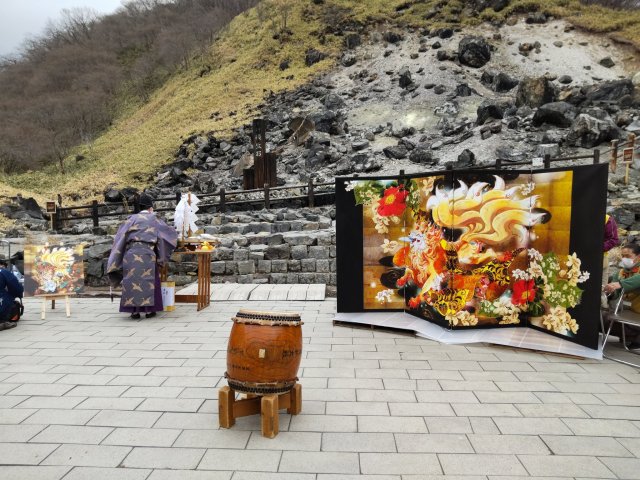
Does this mean the priest’s purification ritual has placated the beast? Or is it an omen of something else to come?
Earlier this month, people in Japan were on edge after it was found that the famous Sesshoseki “Killing Stone” in Nasu, Tochigi Prefecture, had broken in two.
▼ Yes, it’s listed as “Killing Stone” in Google Maps.
The reason why the broken boulder became such a cause for concern was because it was long believed to house the spirit of a nine-tailed fox.
▼ Nine-tailed foxes have appeared in numerous artworks, including anime like Naruto, and this woodblock print by Utagawa Kuniyoshi (1798-1861).
The stone-bound fox at Nasu wasn’t considered to be a friendly spirit, as it had originally shape-shifted into a woman in the capital in an attempt to kill Emperor Toba in the 1100s. To escape punishment, the nine-tailed fox fled to Nasu, where it shape-shifted into a stone that leaked poison, killing people and animals who passed by it.
▼ This is how the “Killing Stone” got its name.
For years, the Killing Stone, and the vengeful fox spirit bound within it, had been pacified with a sacred rope called a shimenawa, which had been placed around it by a priest at the local shrine. So when the stone broke in two this month, a priest from the local shrine was called in to perform a special ceremony called the “Nine-Tailed Fox Nasu Killing Stone Memorial Service and Prayer for Peace Ceremony“.
Memorial services are one way to appease the spirits in Japan, so rather than reseal the boulder with rope, and physically interfere with whatever natural or unnatural forces that led to the stone breaking in two, prayers were offered by the priest to lay the spirit to rest.
The presence of the fox spirit was ever-present at the ceremony, however, with a couple of costumed characters in attendance, along with artwork depicting the mythical beast.
Image: Twitter/@yamatokoyomi
▼ Yep, that’s the nine-tailed fox right there.
Image: Twitter/@yamatokoyomi
Instead of bringing out the two-finger peace-sign pose, this fox brings out the five-finger fox-face pose.
Image: Twitter/@yamatokoyomi
During the ceremony, which took place on 26 March, the attendees joined the priest in bowing their heads as he recited prayers before the altar, where ritual offerings like sake and fresh fruit had been placed. The priest then ascended the rocky steps to stand before the rock, waving a haraegushi (wand made of paper strips) over the area to purify it.
The ceremony also included a performance on a taiko drum by a solo drummer, whose piercing beats echoed eerily around the rocky landscape. Once the formalities were over, Nasu’s local mascot character, Kyubi, a more friendly version of the nine-tailed fox, posed for photos with the other fox in attendance.
The Nasu Tourist Association, who oversees the famous tourist spot and made arrangements for the ceremony, says they hope the religious purification will pacify the “divine beast” and help it to become a lucky omen that brings peace and prosperity to the area.
Image: Twitter/@yamatokoyomi
Whether the ritual has worked to pacify the beast is yet to be seen, but a number of locals believe it had some effect, as a mysterious fog descended upon the area shortly after the purification took place.
▼ This sign reads: “Killing Stone”
▼ The walkway to the stone
Image: Twitter/@bigurou
▼ The Killing Stone
Image: Twitter/@bigurou
The mist that shrouded the stone after the ceremony certainly adds an extra layer of mystery to the broken boulder and the tale of the nine-tailed fox. Was it a sign that the fox’s spirit had left the area? Or could it be an ominous sign of things to come? Perhaps it’s simply the elemental forces of Mother Nature at play, but like many of Japan’s ancient mysteries, we’ll just have to wait and see the outcome.
Sources: Yomiuri Shimbun via Net Lab
Featured image: Twitter/@yamatokoyomi
● Want to hear about SoraNews24’s latest articles as soon as they’re published? Follow us on Facebook and Twitter!